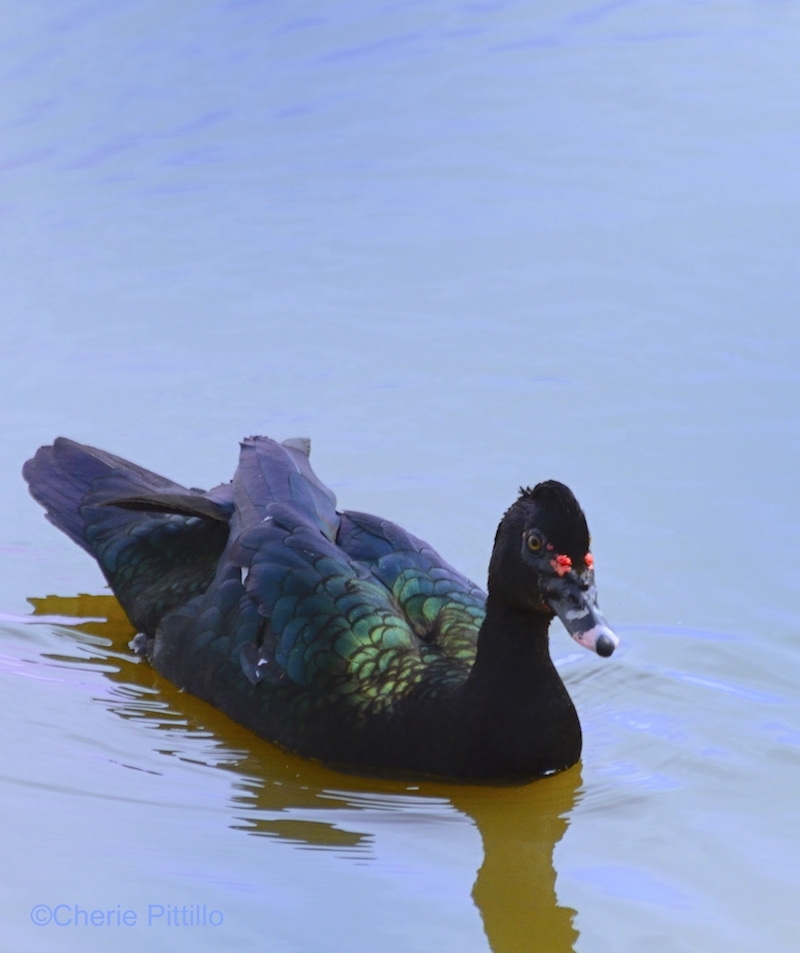MUSCOVY DUCK, Cairina moschata, Pato Real (Spanish), Bo’ox patux (Mayan)
Muscovy. Moscow.
Moscow. Muscovy.
In the year 1271, a principality called Muscovy, centered in Moscow, eventually became modern Russia.
Is the Muscovy Duck named for Moscow? No.
Is it native to Moscow or Russia? No.
Does it live in Russia? No, not unless it’s been introduced there, possibly for food.
Actually it’s native to the tropics of Mexico, Central and South America and a wild population may live in Texas. Many feral and domesticated muscovies live beyond their original countries, even New Zealand.
One source found evidence of domesticated Muscovy Ducks in several archaeological sites. They were used in prehispanic trade which may have changed their geographical distribution. The trading occurred before the Europeans arrived in the Americas.
These large perching ducks prefer wooded rivers, swamps, and coastal lagoons. Luckily I photographed a few in the wilds of Brazil.

Wild Muscovy Ducks
At about eight pounds a male Muscovy is considered the largest duck in North America. It also sports a crest, a few red facial warts (caruncles) and usually a white wing patch. The female lacks a crest and therefore may be “crest fallen.”

Crest of Male Muscovy Duck

Red warts (caruncles) of wild Muscovy Duck
The domestic Muscovy Duck we see in cities and parks exhibits more facial warts than the wild species. Plus it also readily breeds with Mallards, Pekin Ducks, and other domesticated ducks. The result: those ducks sport a kaleidoscope of colors, “smorgasbirds,” so to speak. (Pekin, not Peking Ducks, are the common, domestic, white ducks with orange bills and feet.)
Rare in the Yucatan, several examples of the domestic Muscovy Duck were photographed in Aqua Parque and Eco-Park. Note the heavy, long body and short legs similar to the wild type.

A smorgasbird of mixed Muscovy Ducks

Muscovy X Mallard with long, heavy body and short legs

Domestic Muscovy Duck

Pekin X Muscovy Duck
So how did this North/South American species obtain its name?
I’ve not uncovered a definitive answer.
Several references suggest explorers to North America may have introduced the ducks to Europeans through an English trade company eventually renamed Muscovy Company. It was founded on the premise of establishing trade with Russia, which it did.
This opportunistic feeder consumes a variety of plant matter, along with fish, reptiles, spiders, insects and their larvae, and a taste for termites. It becomes a pest when it feeds in grain fields. In parts of Mexico, it feeds solely on maize.
In the wild it usually breeds in the wet season and nests in tree holes or caves. The male submerges the female while mating. According to field observations, the pair seem to be monogamous, but in captivity, they are not.

Male Muscovy Duck (domestic) mating with submerged female

Submerged female Muscovy Duck mating
Average clutch is 10 eggs and the non-ugly ducklings resemble Mallard young with their dark brown and yellow fuzzy feathers. Unfortunately when the young mature, many people call the adult muscovies, ugly ducks. It’s a reverse swan story.

Domestic Muscovy Duck family

Not ugly ducklings, mixed Muscovy Ducks
REGARDLESS OF HOW WE CHOOSE TO DESCRIBE NATURE, GO OUTDOORS TO APPRECIATE IT.
DISCLAIMER: References do not agree on details about these species.
Sal a Pajarear Yucatan, Birds & Reserves of the Yucatan Peninsula, A Guide to the Birds of Mexico and Northern Central America, Sibley Guide to Bird Life & Behavior, The Crossley Guide, Lives of North American Birds
https://www.hbw.com/species/muscovy-duck-cairina-moschata
https://neotropical.birds.cornell.edu/Species-Account/nb/species/musduc/distribution
https://onlinelibrary.wiley.com/doi/abs/10.1111/j.1474-919X.2006.00564.x
https://www.britannica.com/topic/Muscovy-Company
https://www.popsugar.com/food/Pekin-Duck-vs-Peking-Duck-11823826
Cherie Pittillo, “nature inspired,” photographer and author, explores nature everywhere she goes. She’s identified 56 bird species in her Merida, Yucatan backyard view. Her monthly column features anecdotes about birding and other wildlife in Merida, Yucatan and beyond. Contact: [email protected]
All rights reserved, ©Cherie Pittillo

